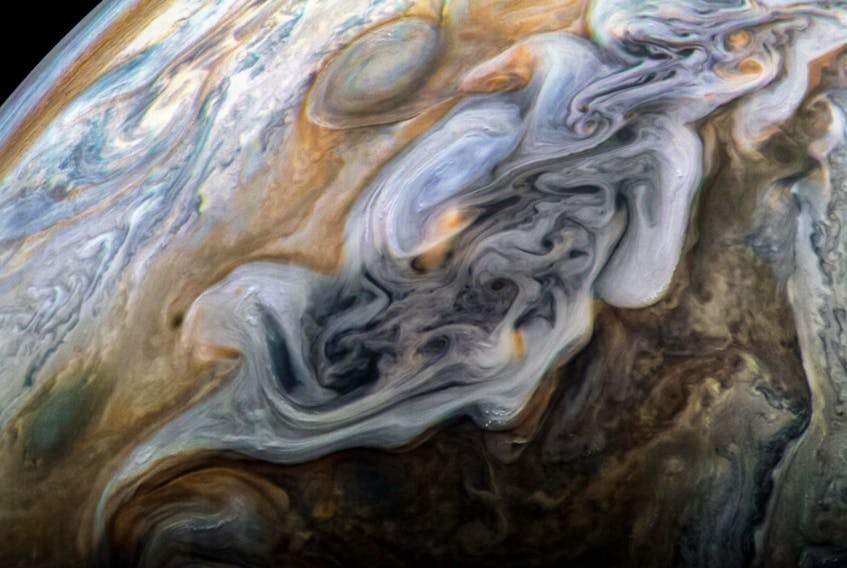Jupiter and Saturn are visible in the southwest as the sky darkens.

Jupiter (mag. -2.0), still in the constellation of Ophiuchus - the Serpent Bearer, sits about 20 degrees (two hands width at arm's length) above the southwest horizon about one hour after sunset, affording only a brief viewing window before it sets around 10 p.m. Look for the thin, crescent moon to the upper left of Jupiter on the evening of Oct. 3.
Saturn (mag. +0.5), in the constellation of Sagittarius - the Archer (between the asterisms of the "teapot" and the "teaspoon") sits about 30 degrees high in the southern sky as darkness falls. It follows Jupiter below the horizon around 11:30 p.m. The brief viewing window for Saturn might, weather permitting, afford a quick view of the planet's magnificent ring system, favourably tilted 25 degrees to outline of sight. A decent scope (4 in. plus) will show the famous Cassini Division between the outer A and B rings. The first quarter moon sits three degrees left of Saturn on the evening of Oct. 5.
Mercury (mag. -0.2) and Venus (mag. -3.8) will both require optical aid to be seen, as they sit very low above the southwest horizon just after sunset. A haze-free sky, and an unobstructed view of the horizon will certainly increase your chances of locating our solar system's two innermost planets. Viewing these planets will get easier in the coming weeks and months.
Comet Africano is still visible in the night sky, slowly drifting through the Pisces - the Fish constellation into that of Aquarius - the Water Bearer (both well placed in the southern sky, about half way to the zenith, by around 11 p.m.) during the first week of October.
Having peaked at mag.+ 9.0 on Sept. 27, 2019 at its closest approach (perigee) to Earth, Africano is expected to maintain its current magnitude until later in October. A dark-sky site, away from city lights, and a good pair of binoculars (10x50) or a decent scope (4 in. plus) will up your chances of spotting this celestial visitor.
Speaking of celestial visitors, C/2019 Q4 Borisov has been confirmed as a comet. Recent observations indicate Borisov to be cometary in nature, due to its fuzzy appearance, indicating a central ice body producing a surrounding cloud of dust and ice particles as it travels sunward. However, its hyperbolic trajectory and its speed (about 150,000 kph) indicate that it is interstellar (from outside our solar system) in origin. Most comets that enter our inner solar system and swing around the sun on an elliptical orbit are believed to come from the Oort Cloud, a vast shell of icy objects thought to surround our solar system.
The Oort Cloud is theorized to extend outward from about 2,000 - 5,000 AUs to approximately 50,000 AUs (roughly 7.5 trillion kilometres) from the sun. One AU (Astronomical Unit) is the average distance from the Earth to the sun, approximately 149 million kms.
Comet Borisov, currently at around mag. +18, is only visible in large professional telescopes at present. It is projected to make its closest approach to the sun (though not around it, as other comets do) on Dec. 8, 2019, and is not expected to come any closer to the sun than a path beyond the orbit of Mars, approximately 300,000 kms.
It may be visible in moderate-size telescopes after that until April of 2020, and in professional telescopes until the end of next year. More about tis interesting comet, and only the second interstellar visitor to our solar system, in future columns.
Until next time, clear skies.
Glenn K. Roberts lives in Stratford, P.E.I., and has been an avid amateur astronomer since he was a small child. He welcomes comments from readers, and anyone who would like to do so is encouraged to email him at [email protected].
Events:
Oct. 3 - Crescent moon to upper left of Jupiter
5 - First quarter moon left of Saturn









